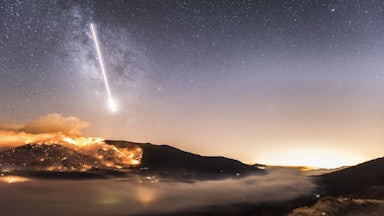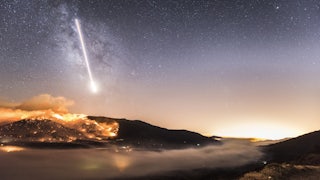On January 13, one week before the inauguration of Joe Biden as the forty-sixth president of the United States and seven long days after the storming of the Capitol by an armed right-wing mob, it was easy enough to miss an article published in the journal Frontiers in Conservation Science, despite its eye-catching title: “Underestimating the Challenges of Avoiding a Ghastly Future.” The headline was itself a train wreck: six dully innocuous words piling up in front of a modifier more suitable to a 1950s horror comic than a sober, academic journal. But there it was: The 17 scientists who co-wrote the article, the experts who peer-reviewed it, and the journal’s editors did not consider the word “ghastly” too sensational, subjective, or value-laden to describe the future toward which our society is advancing with all the prudence and caution of a runaway locomotive. The article’s message was simple: Everything must change.
On its current track, the authors wrote, “humanity is causing a rapid loss of biodiversity and, with it, Earth’s ability to support complex life.” As many as a million animal species—and 20 percent of all species—are facing near-term extinction. Humans have altered 70 percent of the planet’s land surface and “compromised” or otherwise despoiled two-thirds of its oceans, and the climate has only begun to warm. Humanity—or some of us, anyway—“is running an ecological Ponzi scheme in which society”—or some sectors of it—“robs nature and future generations to pay for boosting incomes in the short term.” Only a radical transformation of the systems that govern our relations to one another and to the myriad forms of life with which we share the planet, the authors concurred, could deliver any hope of a “less-ravaged future.”
One week later, Joe Biden took the oath of office and quickly signed sweeping executive orders declaring it the explicit policy of his administration “to listen to the science.” He didn’t use the word “ghastly,” but he did mention “a cry for survival … from the planet itself,” one that “can’t be any more desperate or any more clear.” This was strangely comforting to hear. He rejoined the Paris accord, revoked a slew of Trump-era executive orders, and restored, albeit temporarily, the moratorium on drilling in the Arctic that President Barack Obama had issued on his way out the door. However slow Biden had been to catch on to the true magnitude of the climate crisis during the primaries, he had, after months of sustained movement pressure, apparently begun to come around.
To his credit, in his first week in office, Biden went further than any of his predecessors ever had. He ordered a “pause” on all new permits and leases for oil and gas drilling offshore and on federal land and shut down the Keystone XL oil pipeline, which activists had been fighting for more than a decade. He ordered federal agencies to pursue a “carbon pollution–free electricity sector no later than 2035,” and the full conversion of all government fleets to zero-emissions vehicles.
Perhaps most significantly, Biden’s actions aimed to institutionalize the mitigation of climate change as a priority in the daily workings of the federal bureaucracy. He ordered the creation of an Office of Domestic Climate Policy, a national climate adviser, a special presidential envoy for climate, and, in an explicit echo of the New Deal program—though green only with a lowercase g—a Civilian Climate Corps. He directed federal agencies to “implement a Government-wide approach that reduces climate pollution in every sector of the economy,” to center climate in foreign policy decisions, to eliminate fossil fuel subsidies, and to “promote ending international financing” of fossil fuels. There was even, in the very first section of his first climate order, a mandate for environmental justice and the protection of communities of color that had been disproportionately harmed by polluters. Whether that would mean any real inclusion—“If you’re not at the table, you’re on the menu,” as one South Carolina environmental justice activist put it to me—remains an open question. But as a signal of his administration’s priorities and its sense of urgency, it was, all the climate activists I spoke to agreed, an extremely solid start.
There was of course also a good deal of typical Democratic half-stepping. Why a “pause” on drilling and not an outright ban? (And why had the administration quietly gone ahead and approved 31 new drilling permits anyway?) Why no mention of fracking? Why not just shut down all the oil and gas pipelines that “[disserve] the U.S. national interest,” as the executive order put it, in exactly the same ways that Keystone XL did? And why not immediately declare a climate emergency, which would have opened up executive powers that would enable him to evade many of the roadblocks erected by the 50 Republicans in the Senate? Even Senate Majority Leader Chuck Schumer, no one’s idea of a radical, was urging Biden to do so. “If there ever was an emergency,” Schumer said, “the climate crisis is one.”
Still, with these and more caveats and endless sound reasons for mistrust, after four long years of Trump’s out-and-out denialist, kleptocratic mayhem, the sheer momentum of Biden’s actions did feel pretty good. At least it allowed us to contemplate the prospect ahead with something other than pure dread. But a couple of months into the Biden era, enough time has passed for it no longer to seem impolite to point out that we should not be reassured. The “ghastly future” that those 17 scientists were warning of will still arrive, right on schedule or perhaps a little early, so long as Biden stays within the frame of what now counts as pragmatic climate policy—which, it turns out, is not very pragmatic at all.
Those 17 scientists did not want you to despair. “Ours is not a call to surrender,” they wrote. It was meant as a kick in the ass—a reminder that our only chance is a thoroughgoing transformation. Specifically: “fundamental changes to global capitalism, education, and equality, which include inter alia the abolition of perpetual economic growth.” Radical as this call may seem, it was hardly an outlier demand from a few oddball pinko Ph.Ds. In 2019, 11,258 scientists from 153 countries signed a “Warning of a Climate Emergency” that called for “bold and drastic” changes to the economy, including a shift away “from GDP growth and the pursuit of affluence toward sustaining ecosystems and improving human well-being.” Two years before that, the Alliance of World Scientists made a similar call in a “Warning to Humanity” that garnered 15,364 signatures. We are supposed to listen to science now. This is what the scientists are saying: Everything must change.
A strange sort of faith lies at the core of mainstream climate advocacy—a largely unexamined belief that the very system that got us into this mess is the one that will get us out of it. For a community putatively committed to scientific empiricism, this is an extraordinary conviction. Despite reams of increasingly apocalyptic research, and despite 25 years of largely fruitless international climate negotiations, carbon emissions have continued to rise, and temperatures along with them. We are at nearly 1.2 degrees Celsius of warming already—more than 2 degrees Fahrenheit over preindustrial averages—and three-tenths of a degree away from blowing the Paris accord’s aspiration to limit warming to a still-calamitous 1.5 degrees Celsius. Scientists now expect us to hit that threshold in about 10 years, and large swaths of the Arctic have been in actual flames for two summers running, but most governments with the option to do so are still feeding the beast that got us here.
Even with the grim opportunity presented by the Covid-19 pandemic, which slowed the economy so much that growth in fossil fuel production dropped an almost unprecedented 7 percent last year, governments—ours very much included—have so far dumped much more stimulus spending into high-carbon industries than into renewable energy. It’s as if our economic system, and the politics it breeds, will not allow us to diverge from the straight path to self-obliteration.
The faith nonetheless persists: The market will provide. It has not done so yet, but renewables are perhaps finally cheap enough—cheaper at last than conventional energy sources—that the transition is now inevitable. So the credo goes. The change that is coming will be largely technological: a bold new era of “green growth.” Modern societies erected on dirty coal and oil can be jacked up and shifted to cleaner forms of energy like an old house in need of a new foundation. Government may have a larger role in this transition than neoliberal dogma has recently allowed, but its primary task will still be to encourage innovation and feed the markets by shepherding the resulting growth.
It is no coincidence that some version of this faith, so all-pervasive now that it does not register as a piety, has been reshaping the planet for almost precisely as long as fossil energy—first coal, then oil—has been altering the atmosphere. Capitalism is guided by a carbon creed, an ecstatic vision of a market that chugs along eternally, needing only new inputs—the earth itself, commodified as minerals, or water, housing, health care, or almost any living thing—to spew out wealth that can be shoveled back into the machine, converting more and more of the biosphere into zeros in a digital account: more fleshless, magical money that can be invested once again. If appetites are bottomless, and apparently they are, shouldn’t growth be endless too?
The market’s grip on the political imagination so effectively blinds us to alternatives that we are unable fully to grasp that this is the basic script that the new administration is following. Even the Green New Deal does not substantively diverge from it. The climate crisis, an existential threat to planetary life, must be sold to Wall Street and the public at large as a growth opportunity. On January 31, John Kerry, acting as Biden’s new climate envoy, enthused to CNN’s Fareed Zakaria about “literally millions of jobs” that would soon be created, about all the “new products coming online,” and about oil companies’ newfound passion for “carbon capture and storage and so forth.” The private sector, he said, “has already made the decision that there is money to be made here, that’s capitalism, and they are investing in that future.” If that makes you nervous, it shouldn’t, Kerry insisted. The changes ahead would be like the analog-to-digital shift of the 1990s, only better: “the important point, Fareed, for people to really focus on is it’s a very exciting economic transition.”
If Kerry struck a cheerier tone than that of the doomsaying consensus in the scientific community, it wasn’t just a question of polishing a turd. “Green growth” is mainstream climate discourse. A “green transition” that does not significantly alter existing economic structures—or their vast inequities—is still, for most climate advocates, the only imaginable way forward. Kerry was speaking a made-for-TV version of the sole language available to him—one that in its most basic assumptions excludes the possibility of fundamental social transformation, and of any heresy that casts doubt on the Great God Growth. The one thing all those thousands of scientists agree on is our only hope—that the economic structures that mediate our relation to the planet must be profoundly altered—is the one thing that Kerry and Biden are quite careful not to consider at all.

In climate policy jargon, the crucial concept is “decoupling.” The notion lies deep in the hidden heart of the “sustainable development goals” held dear by international bodies such as the United Nations and the World Bank: Economic growth can be safely divorced from the ecological damage that it has heretofore almost universally wreaked. If the train of capital appears to be hurtling us toward the abyss, we can cut the engine loose and cruise someplace more comfortable: same train, same speed, different destination. Like millions of clean-tech jobs and a crisis-induced transition magically unlocking unimaginable wealth, it is an attractive and reassuring idea. The only problem is that there is next to no evidence that anything analogous has ever occurred, or that it is likely to occur in the future.
Examples of successful decoupling tend to involve shifts in the location rather than the nature of industrial production: Rich countries green their economies by offshoring the manufacture of the goods they consume to China and countries in the global south, which they can then chastise for their lax emissions standards. But Earth’s atmosphere is not divided by national boundaries. Greenhouse gases cause the same degree of global warming no matter where they are produced, and to the extent that this kind of decoupling is a meaningful measure of anything, it is only of the colonial relations that still set the terms for the shell game of global capital.
What policy wonks call “absolute decoupling”—the only kind that would do the climate any good—turns out to be a fantasy akin to a perpetual motion machine, a chimera of growth unhindered by material constraints. One recent analysis of 835 peer-reviewed articles on the subject found that the kind of massive and speedy reductions in emissions that would be necessary to halt global warming “cannot be achieved through observed decoupling rates.” The mechanism on which mainstream climate policy is betting the future of the species, and on which the possibility of green growth rests, appears to be a fiction.
This fiction is nonetheless fundamental to the very math used by international climate institutions. In 2018, the Intergovernmental Panel on Climate Change’s benchmark Special Report on Global Warming of 1.5oC—which announced in no uncertain terms that global emissions must be decreased by nearly half by 2030 and reach net zero by 2050 to avoid cataclysm at an almost unthinkable scale—set out a number of possible scenarios for policymakers to consider. It relied on algorithmic models linking greenhouse gas emissions and their climate impacts to various socioeconomic “pathways.” Whatever other variables they accounted for, though, all of the scenarios envisioned by the IPCC assumed the continuation of economic growth comparable to the past half-century’s. Even as they acknowledged levels of atmospheric carbon unseen in the last three million years, they were unable to conceive of an economy that does not perpetually expand. Fredric Jameson’s oft-cited dictum that it is easier to imagine the end of the world than the end of capitalism was baked into the actual modeling.
At the same time, all but one of the IPCC’s scenarios that envision us successfully limiting warming to 1.5 degrees Celsius rely on the use of technology to remove carbon from the atmosphere after the fact. (The one exception involves converting an area more than half the size of the United States to forest. None of the scenarios imagines that we can reach the 1.5 degrees Celsius target by cutting emissions alone.) But the technology in question is at this point largely speculative. “No proposed technology is close to deployment at scale,” the report’s authors concede, and “there is substantial uncertainty” about possible “adverse effects” on the environment. The international body, in other words, is more willing to gamble on potentially destructive technologies that do not currently exist than to even run the math on a more substantive economic transformation.
A version of this same wager animates the Biden climate plan, which, as Canada, the European Union, the U.K., and South Korea all have, commits to “net-zero emissions no later than 2050.” (China plans to reach the same goal by 2060.) This sounds like great news, and is without doubt worlds better than the status quo ante of no ambitions at all. But “net zero” is a slippery notion. It does not mean zero at all. To avoid exceeding 1.5 degrees Celsius of warming, emissions need to fall 7.6 percent every year for the next 10 years. Even with the pandemic-induced slowdown, global emissions shrank only 6.4 percent in 2020. Since, as Biden reassured a nervous oil industry during the campaign, “We’re not getting rid of fossil fuels for a long time,” net-zero calculations assume some degree of “overshoot”—i.e., they stipulate that we’re not going to be able to cut emissions fast enough, and that we’ll therefore have to rely on those same untested carbon removal technologies to eventually bring us to zero.
But a planet is not a balance sheet. The climate has tipping points—the collapse of the Antarctic and Greenland ice sheets and the Himalayan glaciers, the deterioration of Atlantic Ocean currents, the melting of the permafrost, the transition of the Amazon from rain forest to savannah. We are perilously close to hitting some of them already: In February, 31 people were killed and 165 went missing when a chunk of a Himalayan glacier broke off, releasing an explosive burst of meltwater and debris. In the most nightmarish scenario, which could be tripped with less than 2 degrees Celsius (3.6 degrees Fahrenheit) of warming, those tipping points could begin to trigger one another and cascade, locking us in, as one widely cited study put it, to “conditions that would be inhospitable to current human societies and to many other contemporary species.” Without major emissions cuts, we may reach 2 degrees Celsius of warming before 2050.
That’s a heavy risk to bet against, but there it is, pulsing away inside the net-zero promises that not only politicians but corporate boards have been proudly rolling out. Over the last two years, more and more corporations in fossil fuel–intensive industries—BP, Shell, Maersk, GM, Ford, Volkswagen, at least a dozen major airlines—have made similar pledges. Shell’s plan alone would require tree planting over an area nearly the size of Brazil. By the estimate of the NGO ActionAid, “there is simply not enough available land on the planet to accommodate all of the combined corporate and government ‘net zero’ plans” for offsets and carbon-sinking tree plantations. To save this planet, it appears we’ll need another one. This is what currently counts as pragmatism.
“If there is any one thing that global warming has made perfectly clear,” Amitav Ghosh wrote in 2016, “it is that to think about the world as it is amounts to a formula for collective suicide.” Five years later, the pandemic has drilled the point painfully home. The societies most geared toward individual profit, and most worshipful of economic expansion, have proved least capable of saving themselves. Decades of almost unbroken GDP growth have piled up riches in a few gated compounds while leaving the vast majority of Americans poorer and more vulnerable to illness, imprisonment, homelessness, and the ghastly futures that we know all too well await us. That vulnerability is far from uniform. Covid has charted a precise map of its variegated terrain, of who gets to live and who gets pushed out to die. The same map applies to the climate crisis, too.
It is at this point a truism that the responsibility for global warming is not the common property of humanity but lies overwhelmingly with the few wealthy countries, the United States above all others, that profited most from early industrialization. The corollary truism is that the poor countries that disproportionately suffer the impacts of climate change contributed next to nothing to the problem. We have since learned that what is true in global macrocosm applies at the societal level as well. The wealthy consume far more resources and emit far more carbon than the rest of us. According to a recent Oxfam report, the richest one percent produce 100 times more emissions than the poorest half of the planet’s population, and the richest 5 percent were responsible for more than a third of all emissions growth between 1990 and 2015. Leveling this gross inequity is a question of survival.
As transcendent as the notion is made to sound, the “economy” is not a god or a temple. It is the order that maintains these inequalities: a highly contingent network of relations among human beings and between humans and the rest of the planet. Like everything we might ever hope to make, it is transitory and eminently changeable. Homo sapiens have walked the earth for at least 300,000 years, but coal-fueled industrial capitalism is less than 200 years old. Its latest, fully globalized stage has been around for just a few decades, even if its roots lie in colonial dynamics that date back a few centuries. Our specific modern exaltation of “growth” dates only to the years that followed World War II. It is younger than Joe Biden, Mitch McConnell, Nancy Pelosi, and Donald Trump. Like them, it cannot survive much longer.
Last year, GDP growth in the United States fell 3.5 percent. Emissions tumbled, too. The only other time in the last three decades that they have dropped significantly was, not coincidentally, also the last time the economy contracted. But if it’s guided with intent, the cessation of endless growth does not have to mean impoverishment. The most recent “Emissions Gap Report” from the United Nations Environment Program (UNEP) projects that warming could be successfully limited to 1.5 degrees Celsius if the richest one percent reduced “their current emissions by at least a factor of 30,” which would allow the poorest 50 percent of the planet’s population to increase their per capita emissions “by around three times their current levels.” For the latter, a threefold jump in consumption is the difference between constant want and a life of basic dignity. Billionaires who drop to 1/30th of their fortunes are still multimillionaires.
As innocuous as it may sound, “growth” should be understood to describe the frenzied ruination of nearly every ecosystem on the planet so that its richest human inhabitants can hold on to their privileges for another generation or two. Rejecting the idolatry of growth means tilting the organization of our societies toward other social goods—health, for instance, and the freedom to exist on a planet that is not on fire. This should not be unimaginable. There are infinite other ways to organize a society, and the fact that we are not widely and urgently discussing them is at this point nothing short of criminal. There are voluminous literatures on degrowth, on circular economies, on mutual aid, and, yes, on socialism, too. There is the 99.999 percent of human history during which we managed to not significantly alter the atmosphere or wipe out such an enormous portion of the species with whom we share the planet. There is the living experience of every indigenous community in the United States, and of others around the globe that have been forced to invent ways to resist and survive a system determined to erase them.
Everything must change. The energy system that is heating the atmosphere was poisoning Black and brown communities in America long before climate change emerged as an issue. The industrial food chain that produces roughly half of all global greenhouse gas emissions is also leaving more than a quarter of U.S. families with children without secure access to food and millions more with a uniquely American combination of obesity and undernourishment. The globalized supply chains that fuel international shipping and aviation—which, per the UNEP, “are projected to consume between 60 and 220 percent of allowable CO2 emissions by 2050”—were deadly to local economies as well as to breathing individuals long before the pandemic revealed their extraordinary fragility.
Transportation, health care, housing, education, everything that the Covid-19 outbreak has revealed to be so murderously broken, every aspect of our lives currently controlled by shareholder profits—does that even leave anything out?—must be rethought and rebuilt in the context of terrestrial survival. The white supremacy that threatens to tear the country down while strangling the rest of the globe has proved inseparable from an ecocidal urge to dominate all forms of planetary life. (W.E.B. Du Bois saw it clearly 100 years ago: “whiteness is the ownership of the earth forever and ever.”) It must be confronted head on. A foreign policy constructed to at all costs preserve a hegemony that for most of the last century has hinged on control of the planet’s oil reserves must be radically reconfigured.
It is of course foolish to the point of derangement to imagine that Joe Biden would consent to any such transformation, much less lead the country toward one. Given the current political geography, it would be equally whimsical to suppose that any American politician or movement could ride to power on the message that this planet does not belong to us, that we share it with the dead and the still-to-be-born and with species we have not bothered to notice, and that we must learn to live among them with generosity, humility, and the sort of wisdom that does not come to human beings cheaply. However, it would be just as naïve to believe that current political configurations are any more stable or permanent than the climate, or any less vulnerable to concerted human action. If we do actually listen to the science, then we understand what ghastly futures await us and we know how bold we must be to avoid them. Any politics that presumes to be anything other than suicidal must take that knowledge as its starting point.








